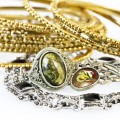How Your White Gold Is Made
White gold is actually made from regular, yellow gold. To change its color, yellow gold is mixed with one or more metals, resulting in an alloy that is white.

White gold ring with white diamonds
Some of the additional white metals used are palladium, manganese and zinc.
The resulting white gold can have a yellowish hue, whose intensity will depend on how much white metal is mixed in – after all, a significant part of the material still consists of yellow gold.
To remove this yellow tinge, many jewelers plate white gold with rhodium. The resulting jewelry looks more like platinum, only a lot more affordable.
Why White Gold Turns Yellow
Most white gold jewelry offered today has been plated with rhodium.
If a piece of jewelry sold as white gold has a perfectly white color, with not a single hint of yellow, chances are you are looking at rhodium plating.
Rhodium plating might be good for giving white gold its color, but this coating is not eternal. Your jewelry is exposed to friction and stress every day, which wear it away.
Eventually, the rhodium covering your white gold will also wear off, and the yellowish lower layer will become visible.
You can slow down this process by wearing your jewelry less often, but sooner or later your white gold will turn yellow.
Keeping White Gold White
The best way to preserve the color of your white gold jewelry, apart from not wearing it, is to have it replated.
Replating is a procedure through which the jeweler adds a new layer of rhodium to your jewelry.
The price you will pay for this service will depend on how worn out the original rhodium coating is and how thick the new layer will be.
In addition to appearance, there is another reason to have your white gold jewelry replated as soon as the plating wears out – the composition of the alloy beneath the coating.
If the gold in the lower layer has been mixed with nickel to become white, and if you are allergic to nickel, then any contact of your skin with the alloy may cause an allergic reaction.
Related: Check out a collection of different white gold diamond rings here.
Don’t Polish Your White Gold Too Often
If your white gold jewelry has a lot of scratches, you may want to get rid of them by having it polished by a jeweler.
However, keep in mind that this process actually involves removing a tiny layer of material from the surface of your jewelry.
If you have your white gold polished too often, all or part of its rhodium plating will also be removed, and it won’t be long before you will have to pay again to get your jewelry replated.
As a general rule, you should have your white gold jewelry polished by a professional no more than once or twice a year.














